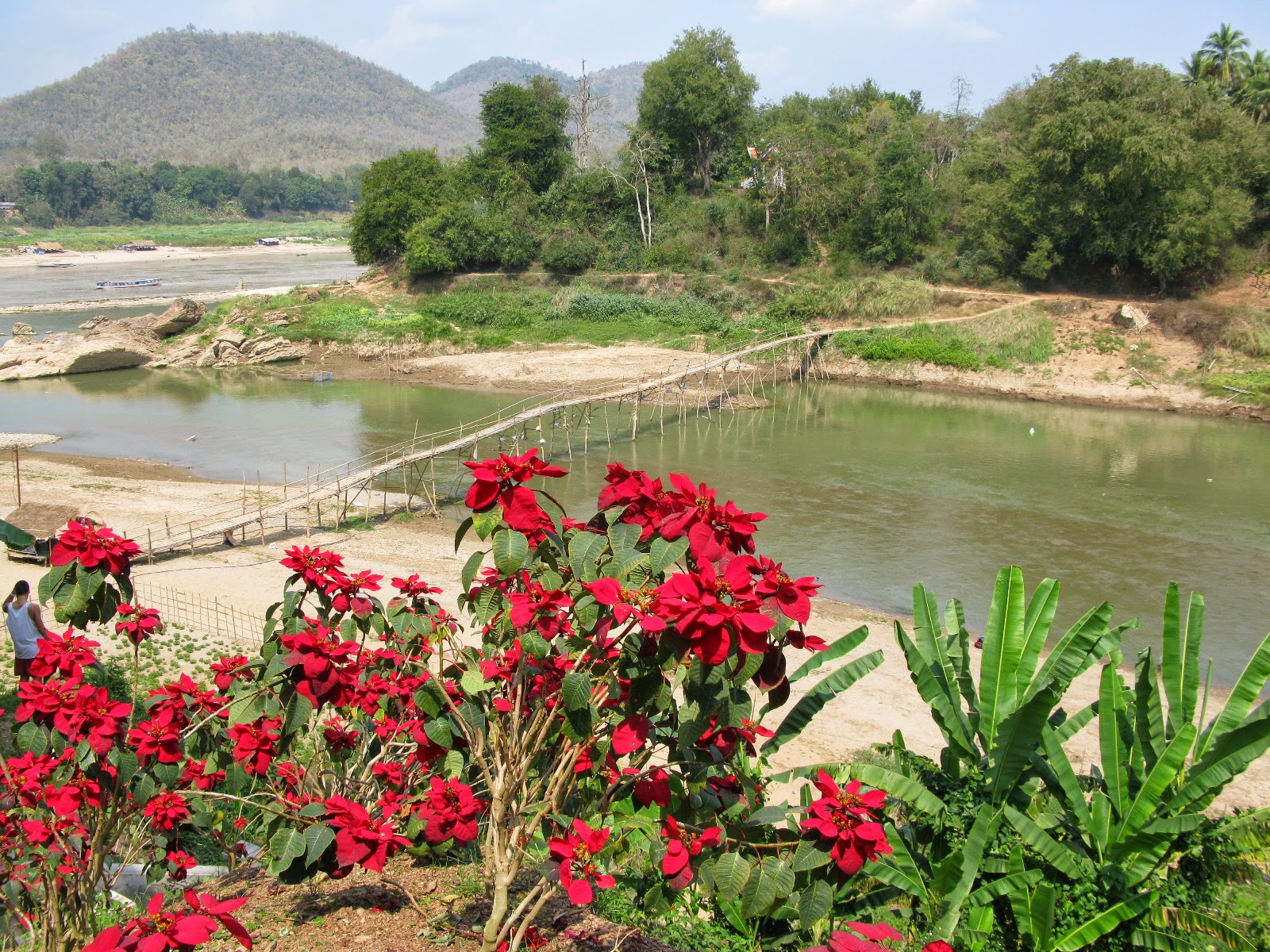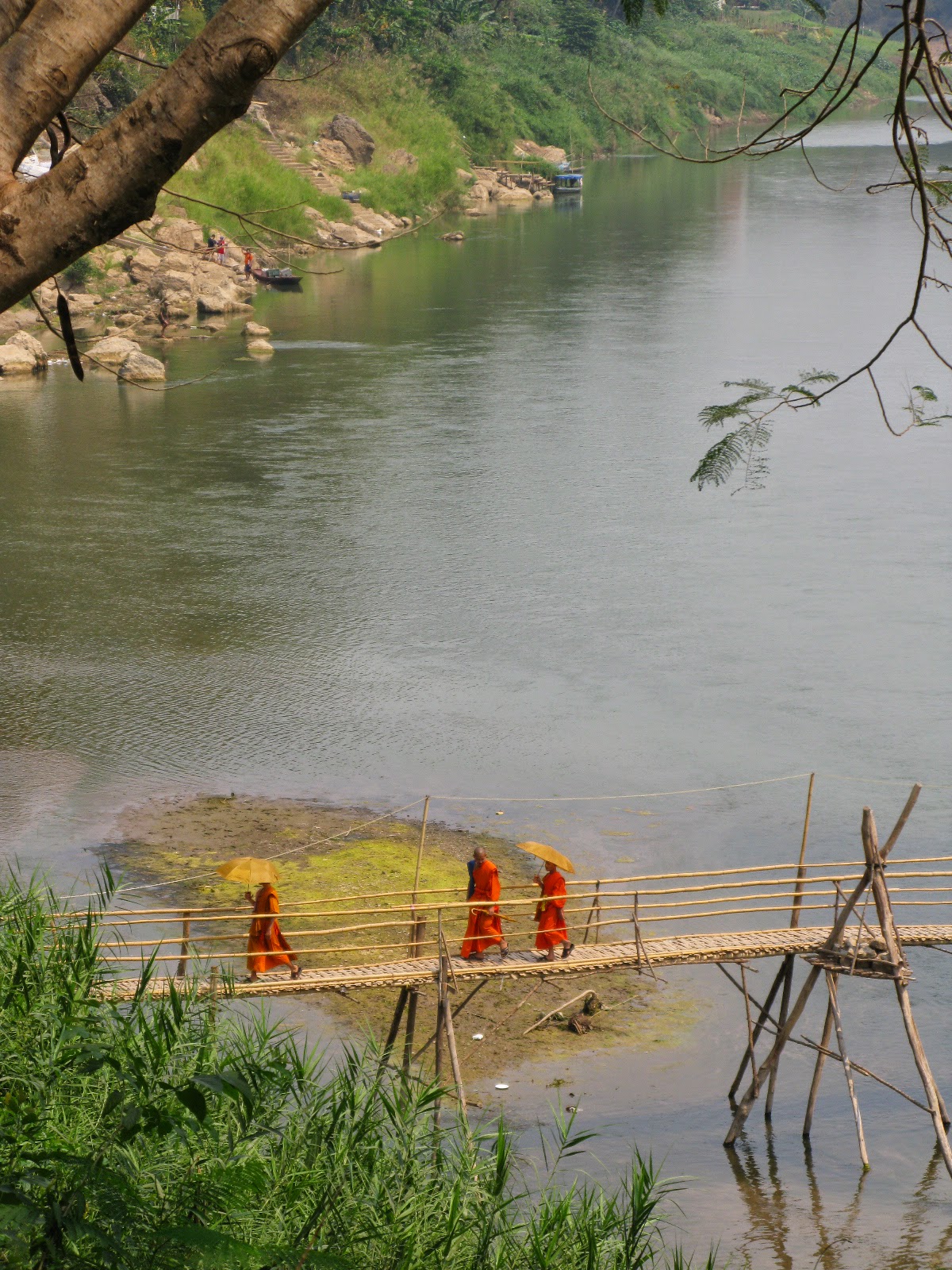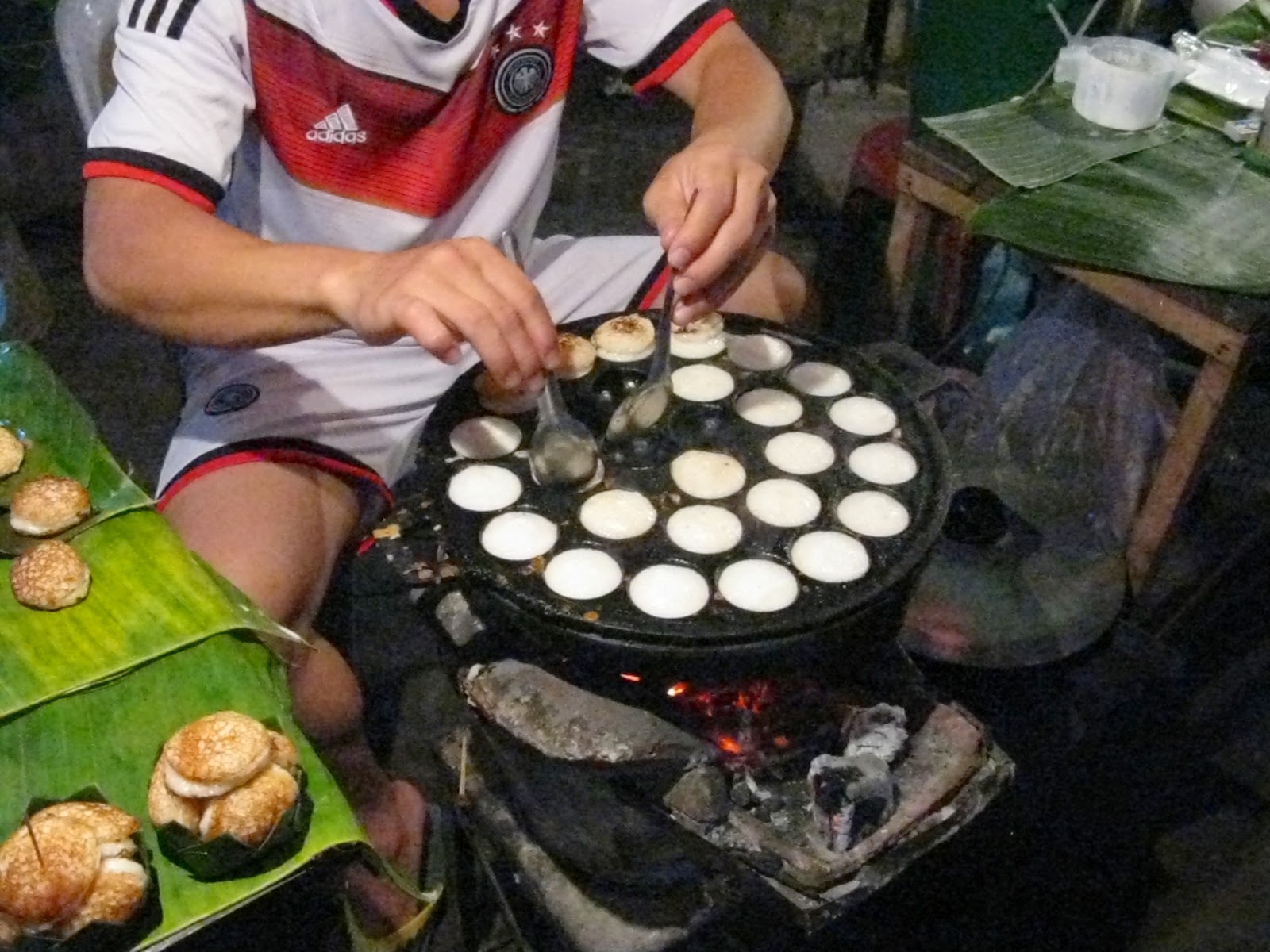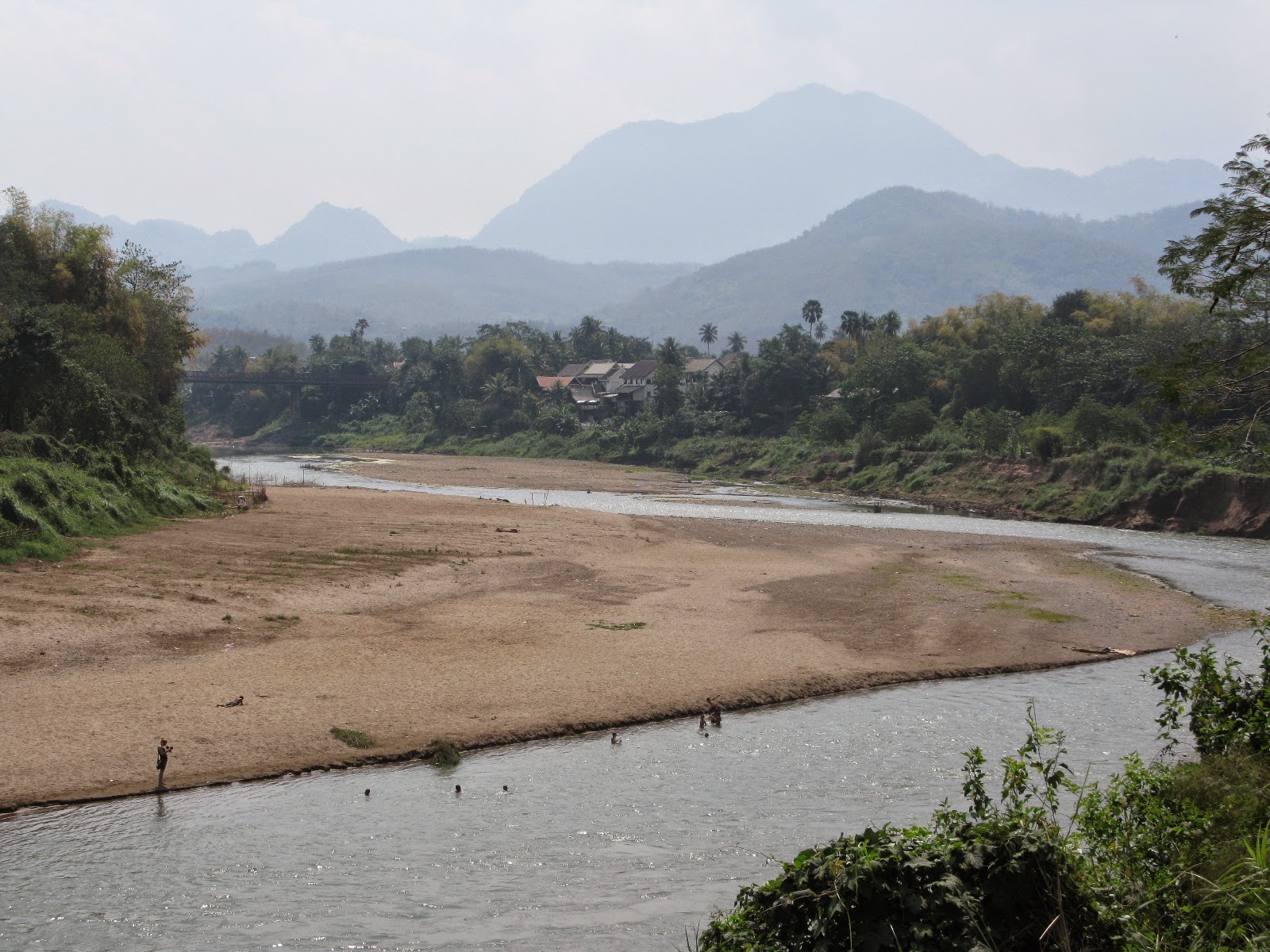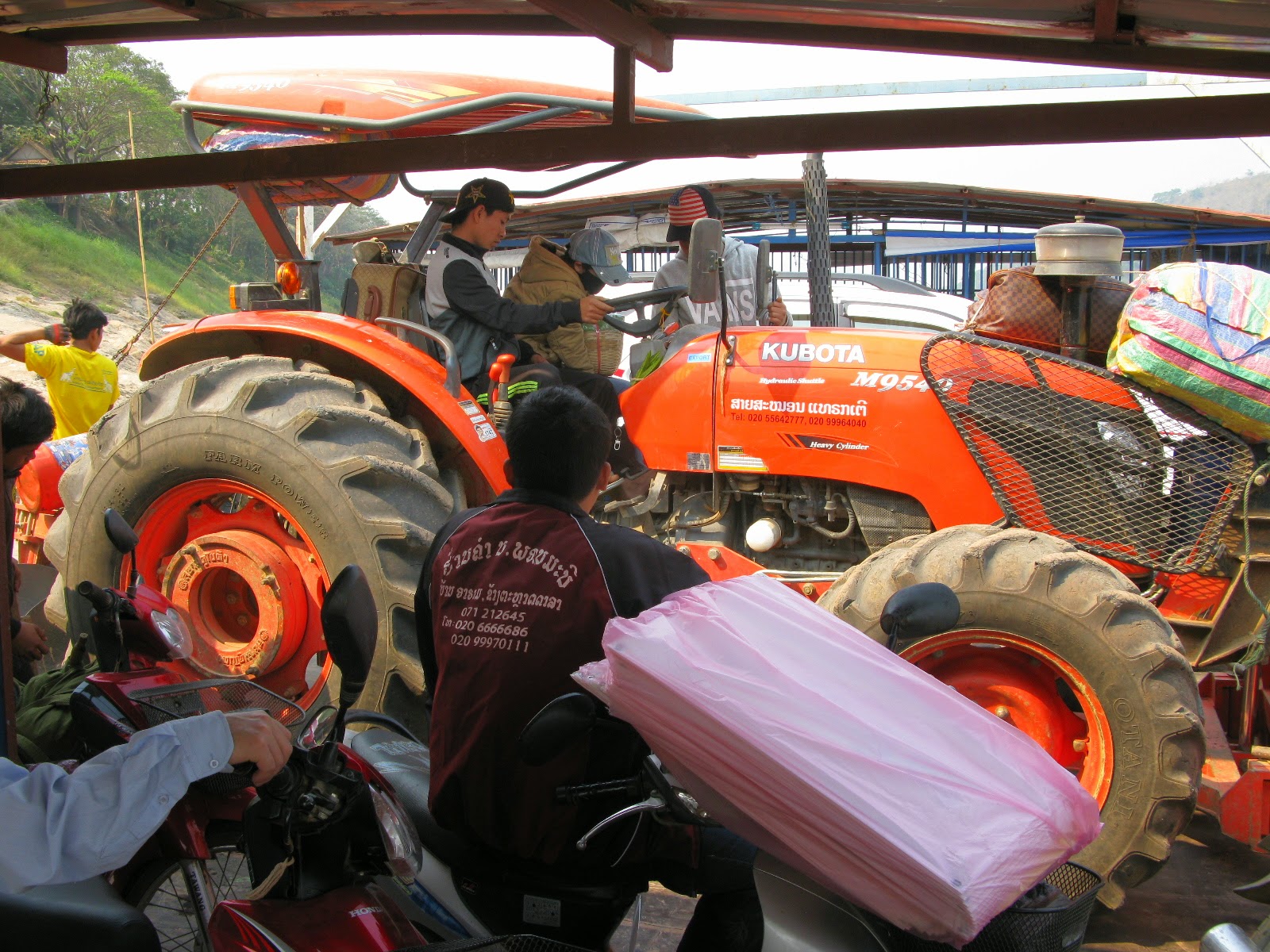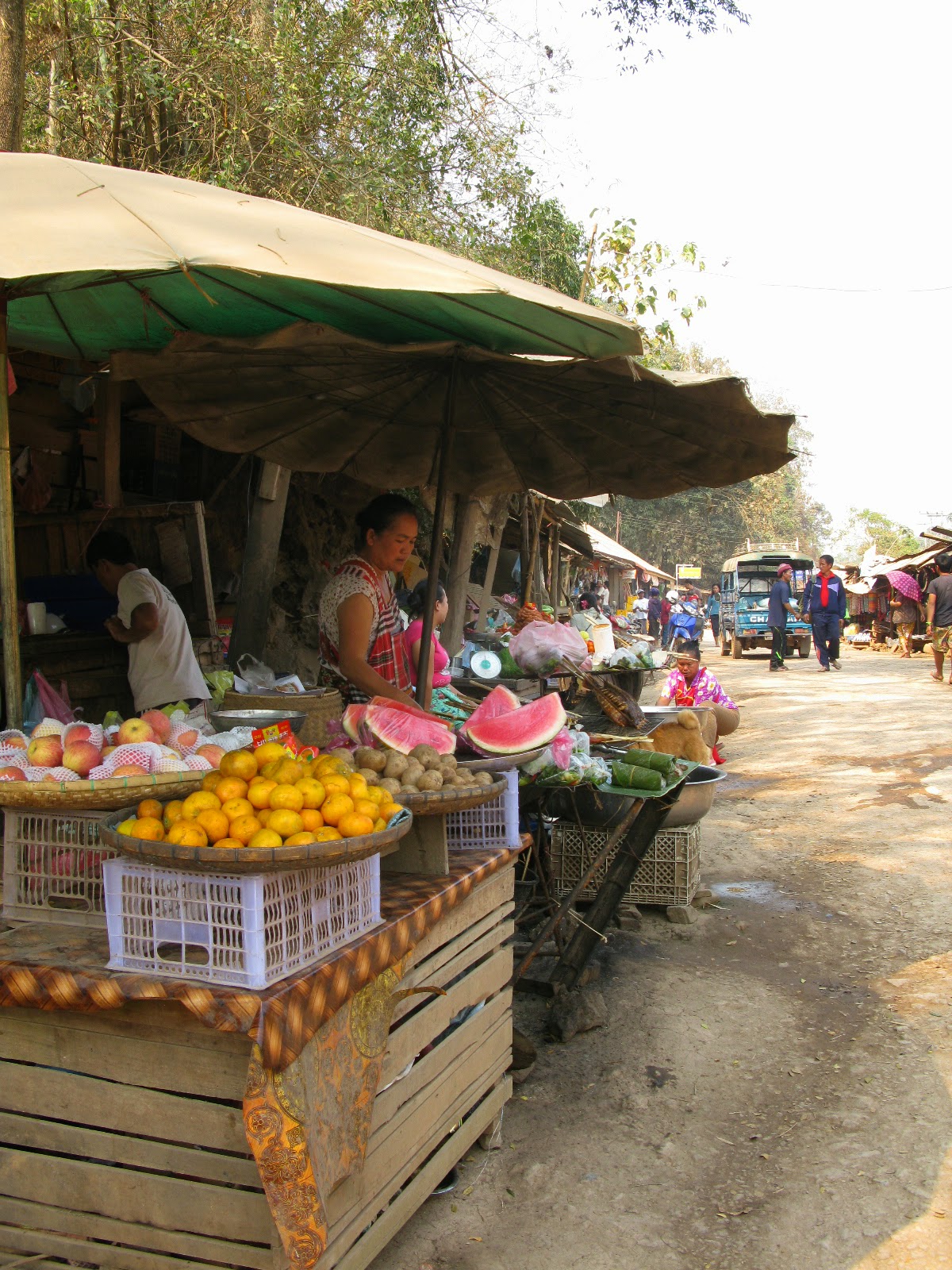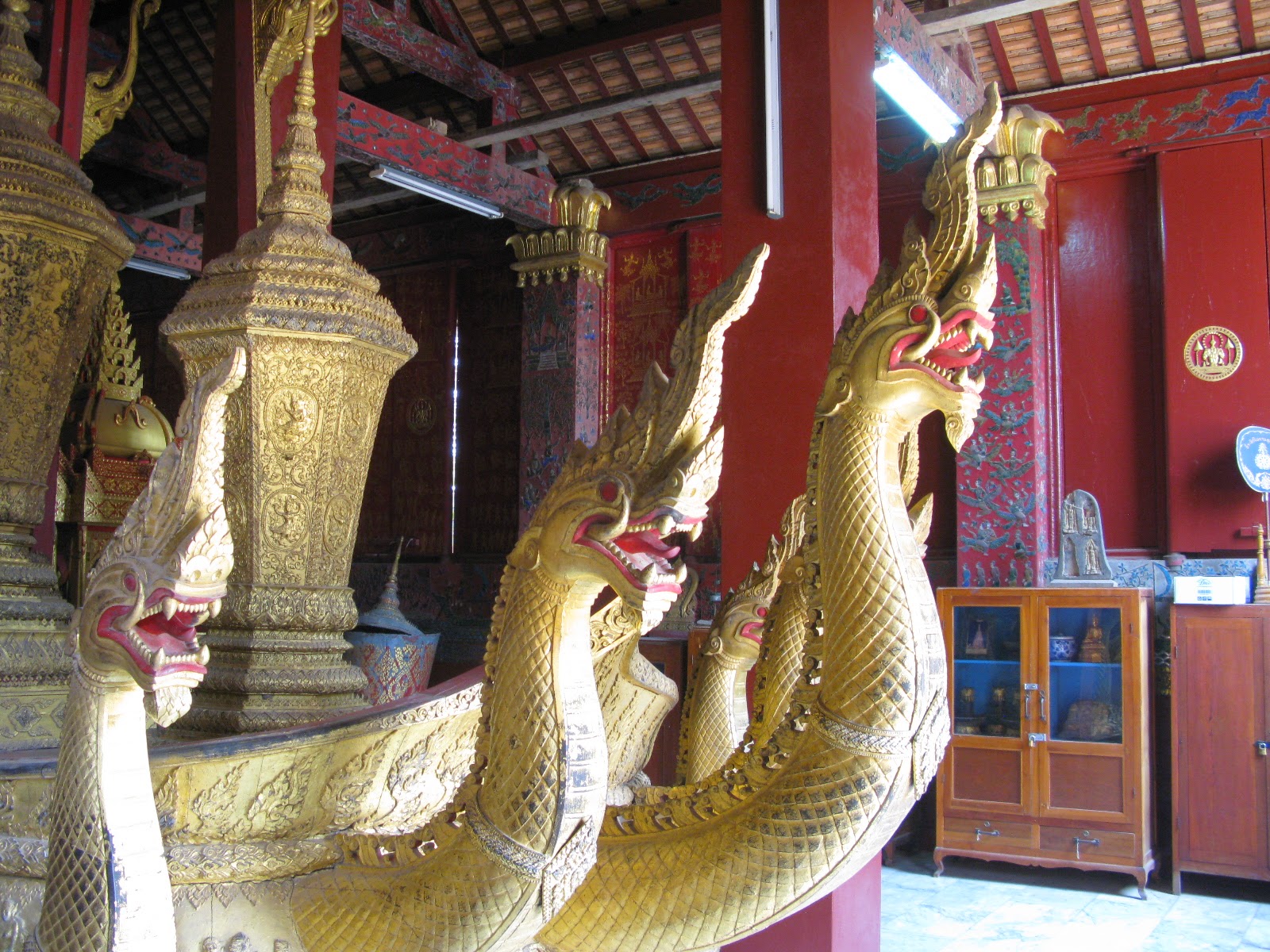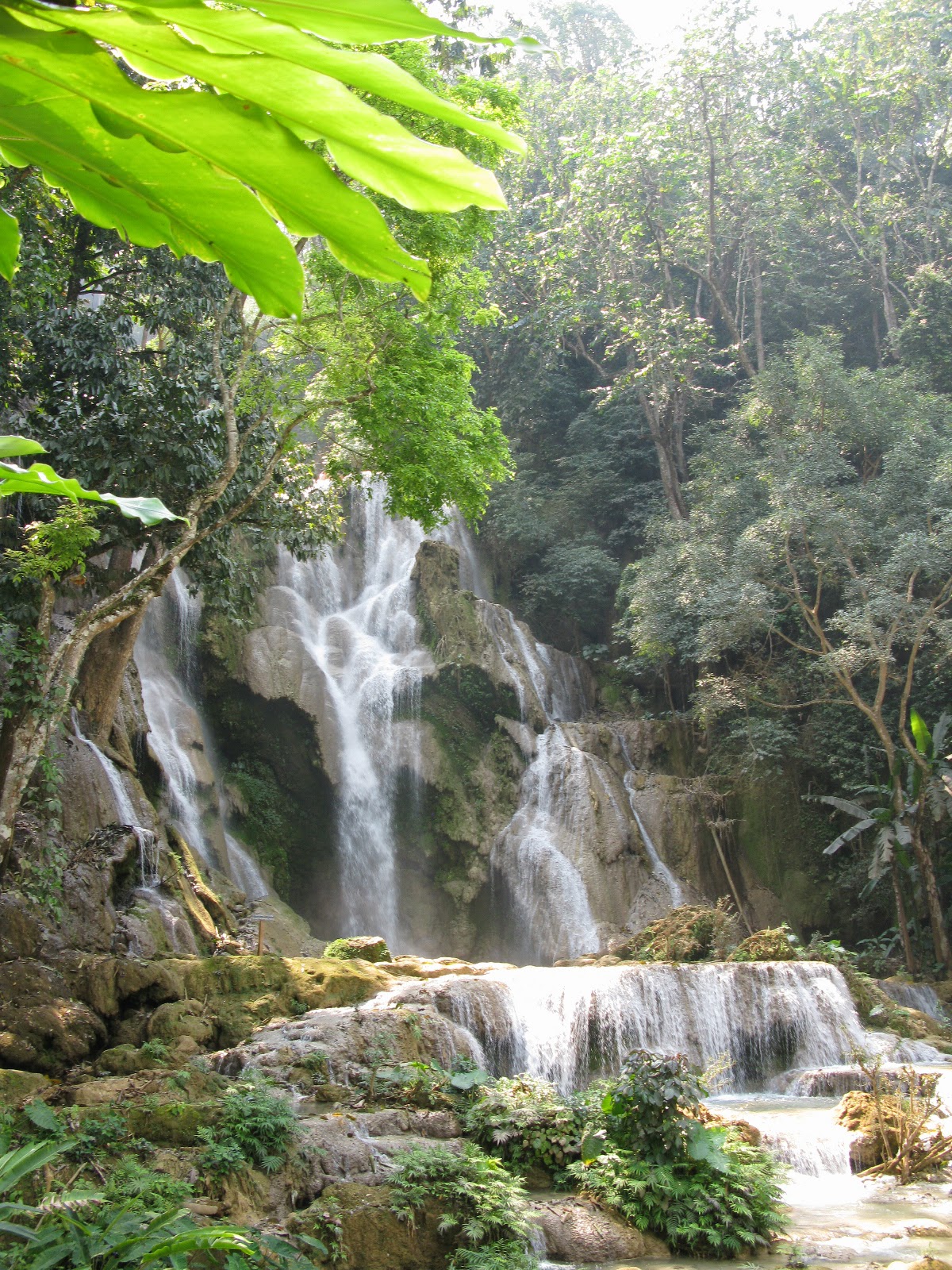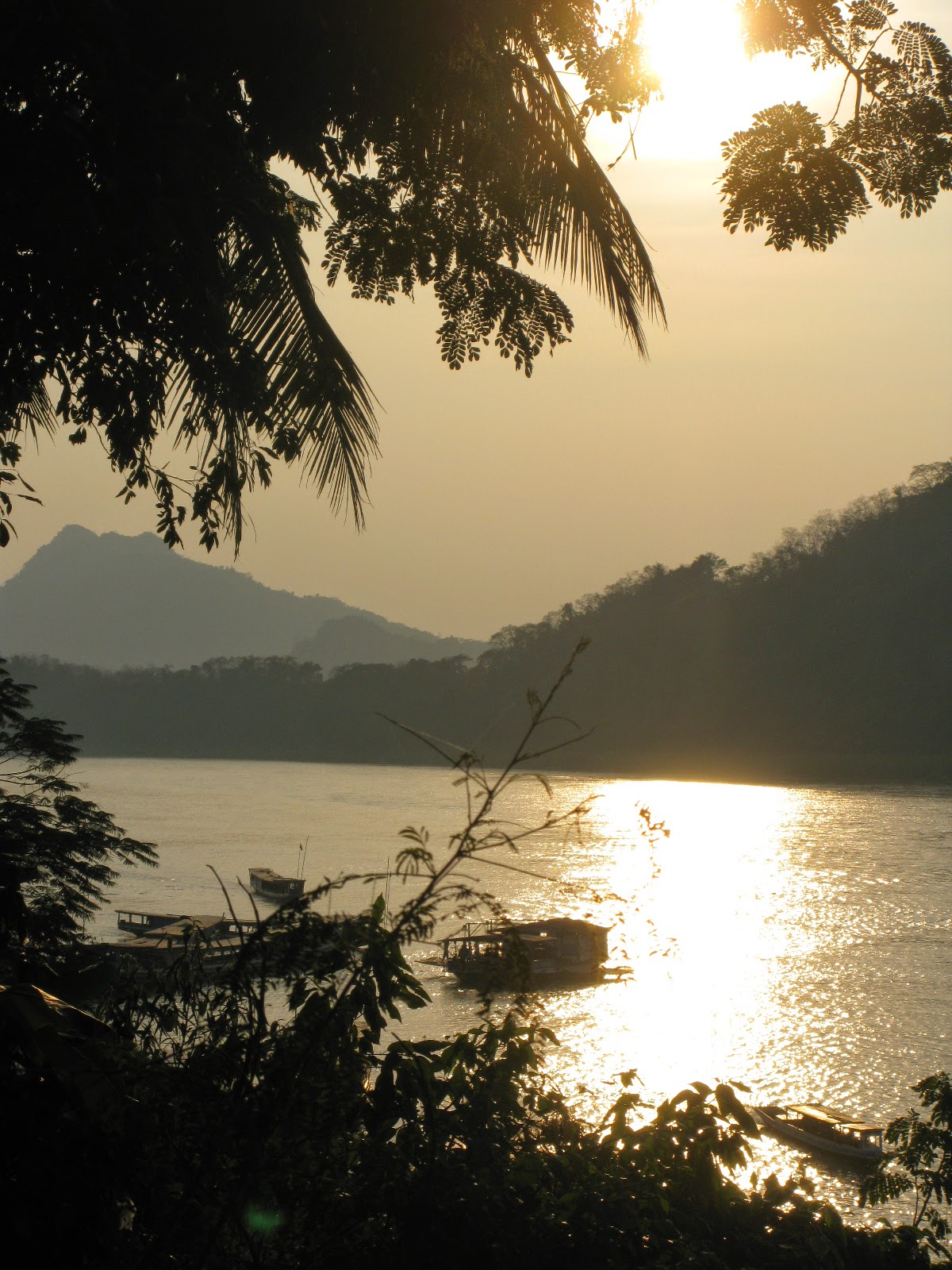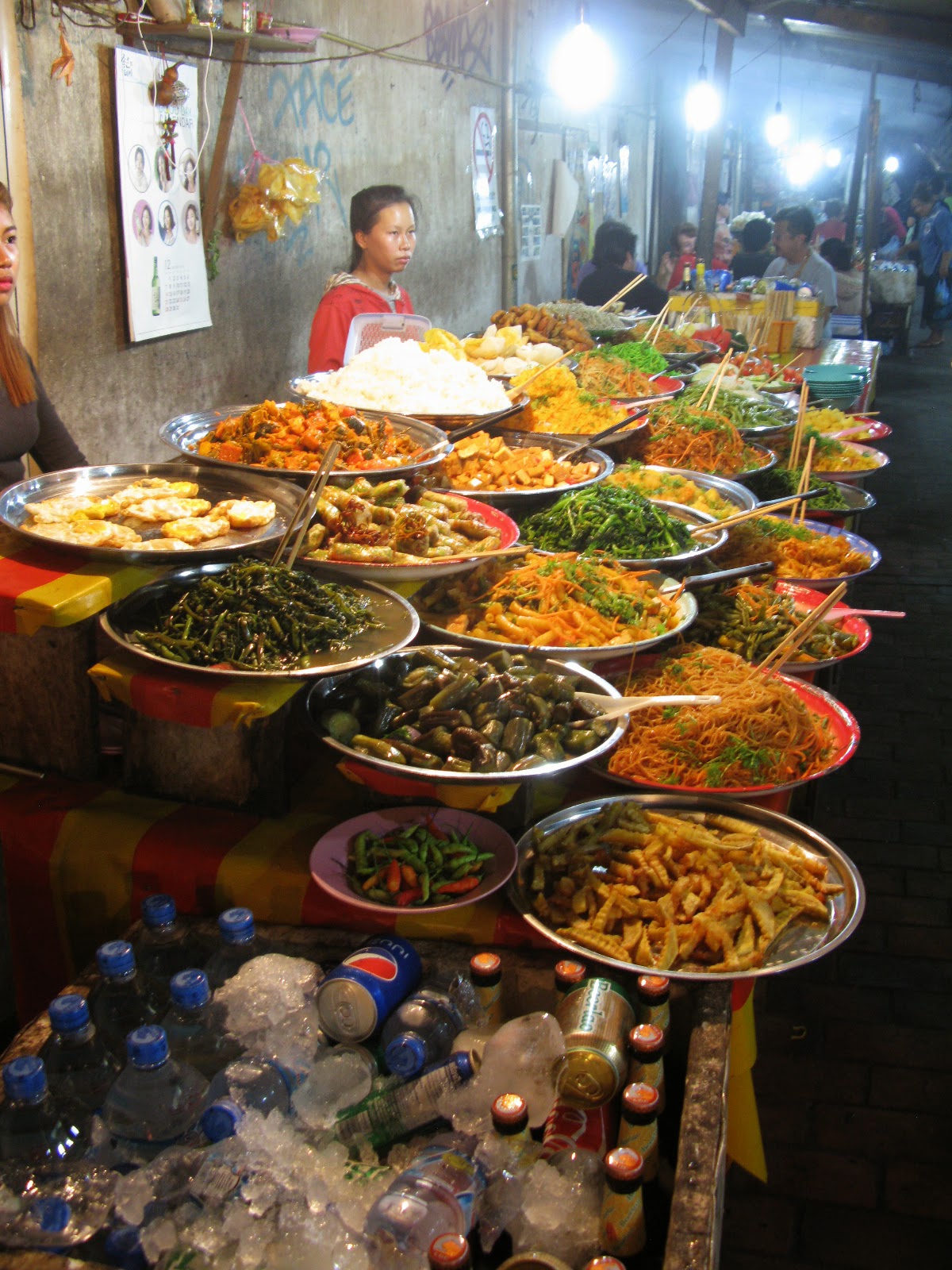If Vientiane is sleepy, Luang Prabang is practically comatose. The old part of town lies on a finger of land, the milk coffee Mekong flowing languidly west along one side, the clear Nam Khan hurrying east along the other side to empty into the Mekong at the fingertip. The Mekong is the working side with passenger boats and fishermen (although it’s very shallow in places), while the Nam Khan, little more than a stream in the dry season, is left for the children to frolic in. The riverbanks on both sides are lined with guesthouses and terrace restaurants to cater for Luang Prabang’s visitors, but tourists don’t overwhelm the place even in peak season. No buses or lorries are allowed in the heritage area and there are no high rise buildings – the shops/ houses/guesthouses are not ancient but they do mostly date from the French colonial period (ie pre 1963) and are appealing hotch potch of balconies, shutters, whitewash and bougainvillea. At the base of the finger, conical Mount Phousi towers above its surroundings like a giant ganglion. If this was Wales, Edward I would have built a castle on the top and fortified the whole promontory – but as it’s Laos, Mt Phousi is crowned by a gold roofed temple, and the peninsula is home to dozens of wats and hundreds of saffron robed monks.
There are no world class Sights as such but it is a magical place for aimless wandering, popping into whatever temple you stumble across, stopping for coffee and a spot of people watching at a café on the main street, or for a welcome icy beer and boat watching on a terrace overlooking the river. It’s particularly interesting to watch the monks – it’s almost exclusively the young ones that you see out and about, always in orange robes but carrying a cloth shoulder bag that is orange, blue or white bearing the emblem of their wat. They walk with purpose but no haste, avoiding eye contact with those they pass – but they all seem to have smartphones!
One of Luang Prabang’s most touted attractions is to watch the early morning alms giving, where monks pour out of the wats clutching a pot in which to collect food, mostly sticky rice, from kneeling residents. Long lines of vivid orange monks in the dawn light make a striking photograph. Unfortunately this tradition (which is a spiritual one for both giver and receiver) has been turned into a tourist scrum, with sightseers (especially Chinese) disrespectfully posing for selfies next to the monks, or inserting themselves into the row of donors complete with stale, inedible sticky rice bought from hawkers (which means the monks then have to discard the contents of their pots). Things have got so bad that the temples want to stop the procession and rely instead on cash donations, but the government is insisting they continue in order not to damage the tourist industry. We made a point of not going to the centre, instead rising early and just walking the streets around the hotel – we were rewarded with a less photogenic but much more authentic experience (with no other tourists in sight) as a small group of monks stopped by some women gathered on a street corner, chanting a prayer before receiving the offerings in silence and moving swiftly on, leaving the women to settle down to what seemed to be a customary gossip.
Climbing Phousi hill is not difficult as there are three paved and stepped paths leading to the top, but it is quite hard work. It’s a popular spot to watch the sun set, but that means walking up in the heat of late afternoon – instead we made the climb in the morning, before the sun’s rays hit the path up the north west side. Bird-filled trees lined the route, and from the top there were 360 degree views of Luang Prabang and its surrounding hills – for a country’s fourth largest town it’s tiny, with less than 50,000 inhabitants. Descending by the south east path the way was punctuated by Buddha statues and a shrine sheltering one of the many ‘footprints’ that he supposedly left behind (even in places he never actually went). All I can say is, if that’s Buddha’s footprint he had very large feet and more than the usual allocation of toes!
It’s quite easy to get out of the city – all you have to do is cross the river. During the dry season a couple of enterprising families construct rickety bamboo bridges across the Nam Khan and charge a toll to pedestrians wishing to avoid a lengthy detour via the road bridge. I suspect the 40p price displayed is for the benefit of tourists and locals pay much less. The north bank of the river is home to a few colonial style guesthouses, but otherwise the quiet, leafy streets are devoid of tourist influence.
To cross the Mekong there is a choice between small passenger boat (no shade, very low in the water, about as stable as a canoe) or vehicle ferry (a raft with an engine and some superstructure). I suspect the passenger boat would have been cheaper than the 40p we paid but we chose the vehicle ferry as more comfortable and more entertaining. As we got on every available male passenger was summoned to help push a truck off the raft and up onto the bank, as its engine wouldn’t start. Then there was much rearranging of motorcycles until, with the deck clear, a huge tractor/plough rolled aboard with large bags of shopping crammed into every available crevice. Its three occupants had clearly been to the market – I suppose that if your only vehicle is a plough, that’s what you go shopping in. The village of Xieng Men on the opposite bank consisted of little more than a street lined with shops selling the usual assortment of dry goods, hardware and fruit & veg, and a paved track running high along the riverbank where the fishermen lived. We walked along until a wat blocked our way, then looped back through an uninhabited forest area before finding our way down the steep drop to the river to make our way back to the ferry along the dried mud of the foreshore, picking our way over boat tetherings and the plastic hoses that were being used to pump water up to the vegetable and marigold plots higher on the bank.
There are two popular excursions from Luang Prabang. One is to take a boat 2 hours upriver to the Pak Bo caves, but it seemed as though the river journey was actually more interesting than the caves, one of which is used as a dumping ground for old Buddha statues that are no longer required. Instead we charted a boat for a one hour river trip – unfortunately we didn’t specify how far we expected to go in that hour, and the driver went so slowly (to minimise fuel use I guess) that we barely made it to the edge of town before it was time to turn around.
The other popular trip is out to the Kuang Xi waterfall – so popular that our guesthouse owner was astonished when he learned that we had been in Luang Prabang for two whole weeks and hadn’t yet been. Tuk tuks charge about 200,000 kip to make the one hour each way journey, but with only the two of us it was cheaper (and faster and more comfortable) to buy a seat in a minibus for 50,000 kip apiece. Sitting at the back, I actually began to feel a bit unwell as the van wound its way into the hills – I’ve travelled so little by road over the last 14 months I think I’m losing my tolerance for it, so it’s just as well we didn’t do the journey from Vientiane by minibus. Although the falls are very, very popular (we overtook numerous tuk tuks en route) the waterfall area is big enough to absorb the numbers without feeling overcrowded (once you get past the inevitable cluster of food and souvenir stalls by the car park). Although the setting is nowhere near as spectacular, the falls reminded me a little of Plitviče in Croatia – a series of shallow turquoise pools spilling over wide ledges into the pool below, with a high, stepped cascade at the head. It was very beautiful and well worth the trip. As a bonus there was a rescue sanctuary for sun bears within the park – it appeared to be well run, with groups of bears in large, natural enclosures searching for the food that had been hidden inside tree stumps and under logs.
A more sombre visitor experience is the UXO Centre, the offices of the organisation responsible for clearing the 80 million items of unexploded ordnance that still litter Laos. The USA, who spent about $2.2 a day ($17m at today’s prices) between 1964 and 1973 dropping the bombs in the first place (on a country with which they were not actually at war!) currently contributes $12m per year towards the clear-up, but even this is constantly under threat. US apologists will argue that Laos was targeted because the North Vietnamese moved supplies along the Ho Chi Minh trail, which is true – but that hardly explains the bombs dropped close to the Thai border in the NW corner of the country. If you look at a map of the bombing, it’s clear that the entire country was targeted. At the current rate of clearance this will take around a thousand years, so meanwhile they also run educational sessions in villages to warn of the dangers – small cluster bombs can be picked up by children, ploughing your paddy field too deep is risky, and even building a bonfire can cause buried bombs to explode. About 300 people are still killed or injured every year.
We were staying a little way out of the centre but there were many other guesthouses around, so the area was by no means devoid of tourists – but our favourite noodle shop, the bright, busy Atsalin, was frequented by as many residents as visitors. I think it’s the only place I’ve been where duck was as cheap as chicken and pork. I’m not sure if the food wasn’t more Chinese than Lao though – in fact, I’m not sure how much genuinely Lao food we ate. One of the problems with Lao food is that a lot of dishes are salads and therefore not freshly cooked, which means dicing with your digestive health (although it’s unlikely that you will be served the really traditional raw minced meat salads). And other things were just too tempting and too easy – a 15-20 minute walk took us to the more touristy centre where we could dine on European food if we wished, including an avocado BLT on lightly toasted herbed focaccia that might just be the best sandwich I’ve ever had, and some light, crispy fish and chips made from Mekong tilapia. One Lao treat in which we did indulge several times was the little coconut cakes, just rice flour, sugar and coconut milk, cooked on the pavement by the west end of the handicrafts market that took over the old town’s main road each evening.
I really liked Luang Prabang – away from the tourist centre it reminded me of travelling 20 years ago, before western influence had penetrated everywhere. With a more forgiving mattress and more effective air conditioning I would have been happy to stay another few weeks – unfortunately the Lao authorities might not have been amused by expired visas, so we went for a last walk along the Nam Khan, ate a final dinner while watching the sun sink over the Mekong, and packed our bags for a flight to Bangkok the next morning. Back to the 21st century with a bump!


